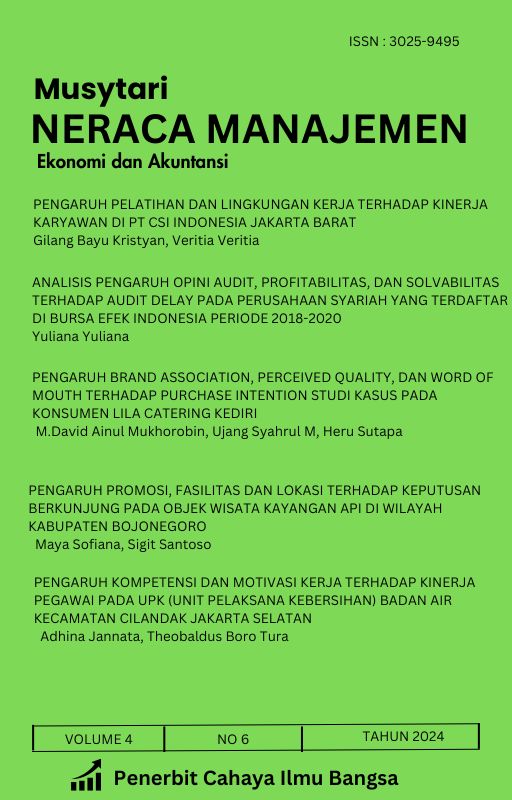THE EFFECTIVENESS OF 360-DEGREE FEEDBACK AS AN EMPLOYEE PERFORMANCE APPRAISAL TOOL IN MODERN ORGANIZATIONS
Main Article Content
Abstract
In the era of modern organizations that demand transparency and collaboration, traditional performance appraisal methods are considered less effective. 360-degree feedback is present as a solution by involving various sources of assessment, such as superiors, peers, subordinates, and external parties. This study uses the Systematic Literature Review (SLR) method to analyze the effectiveness of this approach in improving the quality of employee performance evaluation. The results of the study show that 360-degree feedback provides a more objective and comprehensive picture of performance, and supports the development of individual competencies. Its success is highly dependent on an open and participatory organizational culture. 360-degree feedback is considered effective to be implemented in modern organizations that uphold the values of communication and trust.
Keywords: 360-degree feedback, performance appraisal, organizational effectiveness, human resources, multidirectional evaluation.
Downloads
Article Details
Section

This work is licensed under a Creative Commons Attribution-NonCommercial-ShareAlike 4.0 International License.
How to Cite
References
Astuti, R. (2022). Manajemen sumber daya manusia dalam organisasi modern. Yogyakarta: Pustaka Pelajar.
Atwater, L. E., & Brett, J. F. (2005). “360-degree feedback to leaders: Does it relate to changes in employee attitudes?”. Group & Organization Management, 30(5), 569–598.
Bracken, D. W., Timmreck, C. W., & Church, A. H. (2001). The handbook of multisource feedback. Jossey-Bass.
Dessler, G. (2015). Human resource management (14th ed.). New Jersey: Pearson Education.
Dulebohn, J. H., Ferris, G. R., & Stoddard, D. A. (2005). “The relationship between 360-degree feedback and performance improvement”. Human Resource Development Quarterly, 16(1), 89–107.
Edwards, M. R., & Ewen, A. J. (1996). 360-degree feedback: The powerful new model for employee assessment & performance improvement. AMACOM.
Garavan, T. N., Morley, M., & Flynn, M. (1997). “360-degree feedback: Its role in employee development”. Journal of Management Development, 16(2), 134–147.
Gomes, F. C. (2003). Manajemen sumber daya manusia. Yogyakarta: Andi.
Handoko, T. H. (2021). Manajemen personalia dan sumber daya manusia. Yogyakarta: BPFE Yogyakarta.
Lepsinger, R., & Lucia, A. D. (2009). The art and science of 360-degree feedback. Pfeiffer.
London, M., & Smither, J. W. (1995). “Can multi-source feedback change perceptions of goal accomplishment, self-evaluations, and performance-related outcomes?”. Personnel Psychology, 48(4), 803–839.
Luthans, F. (2011). Organizational behavior (12th ed.). McGraw-Hill.
Mathis, R. L., & Jackson, J. H. (2012). Human resource management (13th ed.). South-Western Cengage Learning.
Nowack, K. M. (1993). “Using 360-degree feedback for management development”. Training & Development, 47(9), 69–72.
Rahardjo, M. (2020). Perilaku organisasi: Teori dan aplikasi. Jakarta: Prenadamedia Group.
Rivai, V. (2019). Manajemen sumber daya manusia untuk perusahaan: Dari teori ke praktik. Jakarta: Raja Grafindo Persada.
Robbins, S. P., & Judge, T. A. (2017). Organizational behavior (17th ed.). Pearson.
Simamora, H. (2021). Manajemen sumber daya manusia. Jakarta: STIE YKPN Press.
Sutrisno, E. (2020). Manajemen sumber daya manusia. Jakarta: Kencana Prenadamedia Group.
Werner, J. M., & DeSimone, R. L. (2011). Human resource development. Cengage Learning.
Yukl, G. (2010). Leadership in organizations (7th ed.). Pearson.
Yuniarti, S. (2021). Psikologi industri dan organisasi: Teori dan aplikasi dalam dunia kerja. Bandung: Alfabeta.
